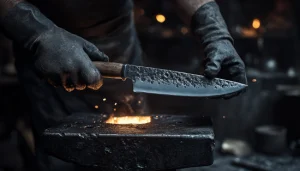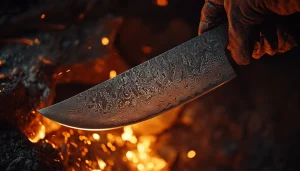Let’s Talk Knives: A Quick Introduction
Knives are much more than just tools; they are an extension of our hands and therefore something with which we work or survive on a daily basis. Whether for cooking, camping, or whatever activity, keeping good care of your knife will make it last longer and always perform at its best. In this article, we look at the importance of caring for your custom knife and give you some maintenance tips to keep it in tip-top shape.
Why Taking Care of Your Custom Knife is a Must
A custom knife is not just a tool but something considered to be a work of art and an extension of one’s personality and style. Contrary to more conventional knives, a custom knife has been handcrafted with special attention to minute details to suit exactly what it will be needed for. It is a possession given value to and a very special one that should have due care.
Taking care of your custom knife goes beyond preserving its beauty; it is about ensuring its functionality and longevity. Here are a few reasons why you should take good care of your custom knife:
- Preserving its Beauty: A custom knife is a thing to awe at, with the highest level of craftsmanship and exclusiveness in design features. Taking care of your knife would keep the aesthetic appeal intact and let the artistic value shine through. Regular cleaning and care will keep off the dullness from dirt, grime, and stains on the blade and handle, allowing the knife to shine forth in all its glory.
- Ensuring Optimal Performance: A custom knife is made to attain unique features for general performance or to accomplish tasks precisely or with ease. For cooking, hunting, or whatsoever good maintenance, it will determine how long it will serve best. Regular cleaning removes debris and residue that would interfere with the optimal performance of the knife; thus, the ability of the knife to cut, slice, and chop easily.
- Preventing Rust and Corrosion: One of the greatest foes of any knife is rust and corrosion. In most instances, rusting of blades and corrosion on handles come because of exposure to moisture, humidity, and acidic substances. Good care of your custom knife will keep rust and corrosion away from it. Regular cleaning, drying, and oiling of the blade create a protective barrier against moisture, therefore impeding rust and corrosion.
- Avoiding Damage and Wear: A well-cared-for knife is less likely to suffer wear and tear. Keeping the blade sharp and the handle in good condition will prevent accidents and ensure a knife functions at its best. Regular checking of the pivot, adding lubrication when needed, prevents any stiffness or grinding from occurring, thus enabling smooth operation.
- Protecting Your Investment: A custom knife is an emotional and financial investment. To take care of a knife well means protecting an investment and, perhaps more importantly, ensuring value retention over time. A well-cared-for custom knife can be passed down through generations, serving as a keepsake that tells its story and holds sentimental value.
Properly taking care of your custom knife is not just about keeping it pretty, but rather about it functioning properly without rusting or corroding, thus getting damaged or worn out. Time and effort will let you enjoy all the capabilities of a custom knife that you can then pass on as part of your heirloom for the next generations. So treat your custom knife with the respect and care it calls for, and you’ll find it serving you with the utmost fidelity in all your cutting intents.
Tips and Tricks for Keeping Your Knife in Tip-Top Shape
- Clean it regularly: Clean your knife every time after its use. You will take it off with warm water, mild soap, and a soft cloth or sponge to remove dirt, debris, or residue. You should avoid harsh chemicals or abrasive materials that may scratch either the blade or the handle of a knife.
- Dry it properly: After cleaning, dry your knife completely to avoid rust or corrosion from moisture. Wipe off with a clean cloth or towel the remaining water on the blade and handle.
- Oil the blade: Applying light oil on the blade could prevent rust from setting in and will maintain the condition of the blade. Only food-grade oil or those intended for knives are to be used. Apply sparingly and remove excess so as to avoid a greasy feeling.
- Check the pivot: Pivot: This is the point where your blade pivots. Make sure a regular inspection is done, and clean it properly for smooth operation. When this is stiff or grinding, do lubricate with a single drop of lubricant designed for knives.
Don’t Forget About Sharpening!
Safety and efficiency depend upon keeping and caring for sharpness. A sharp knife is not only easier to make a cut with and more precise but also minimizes the accident rate due to slips and mishaps. You will need to sharpen your custom knife on a periodic basis, so its cutting edge is preserved and remains fully functional.
Here are some key points to consider when it comes to sharpening and caring for your custom knife:
- Importance of Regular Sharpening: With time and constant use, the cutting edge of any knife becomes dull. Apart from being a pain for any job involving cutting, a blunt knife also requires one to apply more force to cut through, hence leading to slips and accidents. Regular sharpening will keep your blade sharp enough for it to perform at its best performance in your custom knife.
- Invest in High-Quality Sharpening Tools: In an efficient sharpening process, it is important to invest in high-quality sharpening tools that will do the work appropriately. A sharpening stone or whetstone remains the most popular choice for maintaining the cutting edge. If possible, look for a stone with a fine grit that would match the hardness of your knife blade. On the other hand, if one is not confident in sharpening the knife themselves, let the pros do it by seeking professional sharpening service.
- Follow Bladesmith Instructions: Different knives may have their respective sharpening techniques. You could seek instructions from the bladesmith or take advice from the expert on how you can correctly sharpen your custom knife. Many sharpening techniques, if applied inappropriately, may affect the blade and alter its shape, hence reducing its effectiveness and the useful life of such a knife.
- Sharpening Techniques: When sharpening your custom knife, remember to keep the angle consistent and apply even pressure along the blade. Start with the coarse side of the sharpening stone and work your way down to the finer side for a polished edge. Smooth, long strokes are used, flipping sides to ensure sharpening is evenly done. Remember to rinse the blade and dry it completely after sharpening to get rid of the bits of metal.
- Honing the Blade: Along with regular sharpening, honing of the blade is important for keeping your custom knife sharp. Honing is the process where the microscopic teeth of the blade, besides cutting, keep it sharp between sharpening. Take a honing rod or ceramic honing stone and gently run the blade along the rod at a constant angle. Repeat a few times on each side of the blade.
- Proper Storage: The proper storage of your custom-made knife is also another contributor to maintaining sharpness. Do not store your knife in a cluttered drawer or together with other utensils because this will surely dull the blade of your knife or it can get damaged. You can plan on using a knife block, a magnetic strip, or even a sheath to protect the blade and keep it sharp.
Regular sharpening will help your custom knife maintain the keenness of its cutting edge. It’s very important to invest in good-quality sharpening tools, follow the instructions provided by the manufacturer, and sharpen it accordingly. Further honing of the blade and proper storing of the knife will also complement the maintenance of sharpness. This way, investing some time in sharpening means you care about the optimal performance of your custom knife and offer yourself safety and efficiency when cutting.
Storing Your Knife Properly
Proper storage is crucial to protect your custom knife from damage and accidents. Consider the following tips:
- Use a sheath or blade cover: When not in use, store your knife in a sheath or blade cover. This provides protection against scratches of the blade and accidental cuts. Make sure the sheath is clean and dry before storing the knife.
- Store in a dry place: As rust and corrosion can be promoted by moisture, your knife should always be kept in a dry setting. Do not keep the knife near the sink or even in a wet basement. You can add an absorbing packet or silica gel if you want.
- Keep it away from children: Knives are sharp objects and should be stored out of reach of children. Use a lockable drawer or a dedicated knife block to ensure safety.
Final Thoughts on Knife Care
Taking care of a custom knife is not an event but rather a commitment. By applying these maintenance tips and incorporating them into your routine, you will be able to extend the life of your knife and well on into the future enjoy its optimal performance. Thus, a well-maintained knife is a reliable friend for all your cutting needs.
Happy Cutting!
Conclusion: Taking care of a custom knife is very much an important thing in respect to the life and performance of the knife. The key ways of maintaining the knife include: regular cleaning, proper drying, oiling the blade, checking on the pivot, sharpening, and correct storage. This way, you ensure that your custom knife stays at the top shape it was meant to serve all your cutting activities. Now take some time and do some care for your knife, happy cuts!




